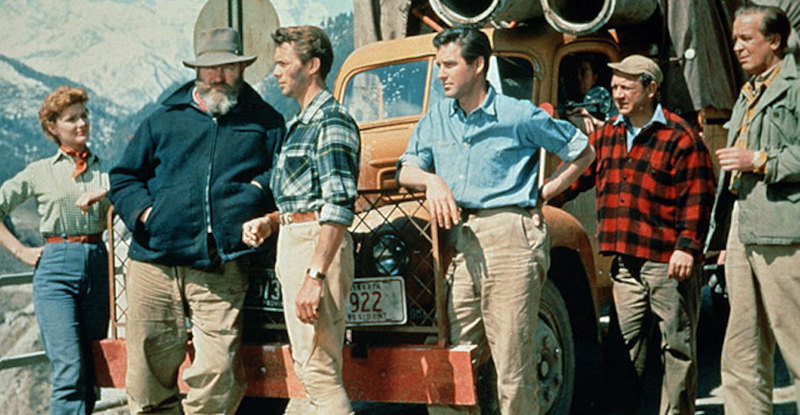Based on the novel by Julia Leigh, writer-director Daniel Nettheim presents “The Hunter” (2011) as one man’s journey in the Australian landscape. While the film’s title might suggest some sort of a hunter-hunted relationship, the film is a rather somber affair, lacking the action elements of a traditional survival movie. This aspect is obvious in the opening act, wherein the plot moves slowly and the narrative is dominated by a lead character’s point of view. The film’s story attempts to depict an interaction of a loner with nature and how it changes his heart.
Willem Dafoe plays the lead character, a mercenary named Martin David, who is sent by a biotech company, Red Alert, to find the last living Tasmanian tiger. David travels to Tasmania in search of the tiger, under the pretense that he is working as a university professor. In town, he has run-ins with the local loggers who think of David as an environmentalist. Unable to find a place to live, David finds a temporary residence at a small cottage inhabited by Lucy (Frances O’Connor) and her two kids, Sass (Morgana Davies) and Bike (Finn Woodlock). It is revealed Lucy’s husband, who was an environmentalist, died in the Tasmanian wilderness, and Lucy, still grieving the loss of her husband, is on prescription drugs. In the meantime, David sets traps in the forest based on the tiger’s whereabouts.
Dafoe’s performance is the central attraction of the movie. Here, he plays as a lonesome character who doesn’t interact much with people. But when he arrives at Lucy’s house, his interaction with Sass and Bike opens him up; they force David to respond in weird situations. We assume David never had a family of his own, and he gradually feels comfortable in the house, thinking that it is his home he never had. In spite of the closeness to the family, David is a respectful and moral individual. This becomes prominent when Lucy, under the influence of a prescription drug, thinks David is her husband. Slowly, David develops a fondness for Lucy, but the film never emphasizes this aspect in the story line. As a mercenary, David understands the rules of the game clearly and possesses amazing killer instincts, enabling him to stay on top of his game. In addition, he is also a very thoughtful individual, weighing in everything before making his move—a trait that helps him later. David’s face looks emotionally weary and painful, which is the result of him leading a lonely, mercenary life far too long. But with living with the kids and Lucy transforms David to a father-figure, and he starts to care for the family even more now. Dafoe has played similar roles to this in the past, and this is the reason he comes across as a perfect fit.
As I said at the start, “The Hunter” is an introspection of David’s mercenary life, leading the way for a changed David. Unlike the recent survival movie “The Grey” (2012) that combined both philosophical and action elements, “The Hunter” is purely a character study. Those looking for thrills will be disappointed. In fact, the movie has a quiet tone that is surely going to frustrate some viewers. In many ways, the film is overly atmospheric, making effective use of nature to represent the vastness of the wilderness. Nonetheless, the core concept of a hunter remains intact even if the film plays like a drama. In technical terms, the cinematography features beautiful scenery, and the impact of the images is fully realized by the film’s serene soundtrack; we are made aware of the dangers and beauty of the wilderness at the same time. In the end, even though the film lacks exciting sequences, the story and performances leave a lasting impression.
Video:
Magnolia presents “The Hunter” in an aspect ratio of 2.35:1, encoded using an AVC codec. The film was shot on 35mm film, and the results are outstanding. The transfer possesses increased depth and consistent sharpness even in tough lighting conditions. There are no bold colors in the film’s palette, and the hues are deliberately subdued. Having said this, the colors look well-produced. The contrast is set perfectly in variable light conditions. The scenery around the Tasmanian forest is beautiful, and the 1080p transfer captures the natural beauty with memorable, sharp-looking images. The close-ups are good looking, too, and skin tones are realistic.
Audio:
Magnolia has included a 5.1 DTS-HD Master Audio track for this release. “The Hunter” is mostly a dialogue-driven drama that is relatively quiet, contrary to what the title suggests. The dialogue gets a boost, especially in the mid range, and it remains consistently crisp and clean. The front channels are fairly active throughout. The soundtrack captures the serenity of the Tasmania forest, and we hear atmospheric noises. There are occasional thrilling moments in which we hear sounds from the rear channels. In addition, the movie can be watched with English subtitles.
Extras:
First, we get an audio commentary track with director Daniel Nettheim and producer Vincent Sheehan. They describe scenes in great depth, talking about the sets, ideas, script, and story. Next, there is a four-part “Making-of” featurette describing the filming process, the shooting in Tasmania, and the film’s characters and story. This is a terrific segment. Up next, there are a number of deleted scenes, mainly focused on character development. And there is the film’s theatrical trailer.
Parting Thoughts:
Featuring an ever-reliable Willem Dafoe, “The Hunter” is a different movie in terms of tone and story. The film derives its power from the performances and the masterly composed images of the Tasmanian forests. Even without the action elements, the film never becomes boring, and it manages to present unexpected things in the plot. The 1080p transfer is superb, along with a good-sounding audio track and a few nice extras. Fans of Dafoe will not be disappointed.


